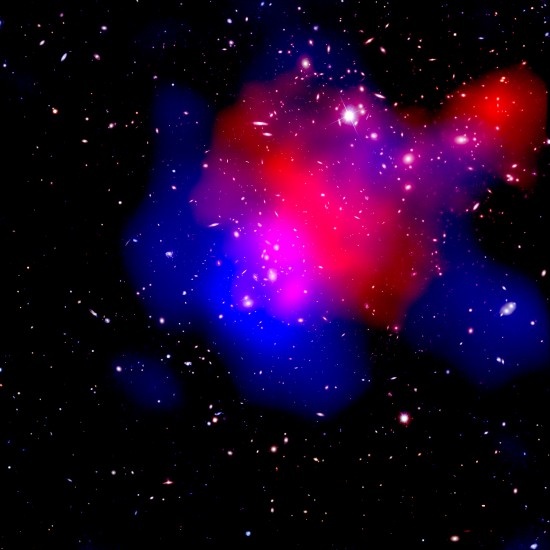
Galaxy cluster Abell 2744 (Pandora’s Cluster), with X-ray emissions in red. Credit: NASA, ESA, ESO, CXC and D. COE (STSCI) J. Merten (Heidelberg/Bologna)
Oct 24, 2014
If redshift equals distance calculations are incorrect, the Universe could be a much different looking place.
“Of course, if one ignores contradictory observations, one can claim to have an ‘elegant’ or ‘robust’ theory. But it isn’t science.”
— Halton Arp
The speed of light is used as a benchmark for defining cosmological distance calculations. As discussed in past Picture of the Day articles, the shifting of Fraunhofer lines into the red end of electromagnetic spectra is thought to determine “recessional velocity”. Standard theories state that the faster an object recedes from observation platforms the farther away it is. This is said to be caused by the primordial Big Bang explosion and subsequent expansion of the Universe. Therefore (according to consensus theory), a faster recessional velocity means greater distance, which means the observed object exists in an earlier time period.
Some massive galaxy clusters with high redshift are seen to shine brightly in X-ray wavelengths. As most astrophysicists think, the presence of “hot gas” encompassing the clusters, with temperatures of 100 million Kelvin, makes them some of the most energetic X-ray sources, since they are calculated to be at a redshifted distance of z = 1, or 13,770,000,000 light-years away.
Such massive clusters are thought to confirm the existence of dark energy because dark energy causes acceleration in the expansion of the universe. That acceleration makes it more difficult for massive clusters to hold together in more recent times because dark energy expansion wants to tear them apart.
Astronomers “discovered” that the Universe is expanding faster today than it did in the past about 15 tears ago. In order to accommodate anomalous redshift observations, the existence of a force that exerts negative pressure on gravitational fields was proposed and later called “dark energy” because it cannot be detected with any instrument.
Enzo Brachini from the European Organization for Astronomical Research in the Southern Hemisphere (ESO) wrote: “This implies that one of two very different possibilities must hold true. Either the Universe is filled with a mysterious dark energy which produces a repulsive force that fights the gravitational brake from all the matter present in the Universe, or, our current theory of gravitation is not correct and needs to be modified, for example by adding extra dimensions to space.”
Presumptions are difficult to overcome, which decreases the ability of conventional researchers to understand several factors that hamper their ability to grasp the fundamental nature of the cosmos. Brachini’s comments—a respected scientist employed by ESO—are a perfect example of the absurd conclusions that can be drawn when electricity in space is ignored.
Dr. Halton Arp earned his place at the top of his field through years of research and many lonely hours on cold mountain peaks, documenting far-flung celestial objects. As his galactic compendium grew, he noticed that there was something wrong with conventional time-speed-distance calculations, since he discovered objects with higher redshift values in front of objects with lower redshift. Surely, such a conundrum should have immediately called into question the very nature of that “cosmological constant”.
If redshift is not an indicator of distance, those massive, bright galaxy clusters might not be so far away and therefore not so massive or bright. As Arp and his colleagues have repeatedly shown, taking in a wider field of view often reveals similar objects on the opposite side of a nearby active galaxy. Many of these high-redshift pairs are connected across the galaxy with a bridge of radiating material. Theories of an expanding universe, dark matter, and dark energy depend on an extremely narrow field of view and a (presumably) biased data selection method.
The story of Halton Arp’s experiences with the scientific community has been documented many times. Suffice to say, a respectful and open-minded reception from astronomers and astrophysicists was not to be the result of his discovery. Rather than accepting his observations, Dr. Arp’s papers were barred from publication and his telescope time was canceled. He was shunned by colleagues and ignored by the community at large, one of the most shameful chapters in a book filled with instances of shoddy treatment and blind resentment.
Referring to material with a temperature of 100 million Kelvin as “hot gas”, astrophysicists are highlighting their complete ignorance of plasma and its behavior. No atom can remain intact at such temperatures: electrons are stripped from their nuclei and powerful electrical fields develop. The gaseous matter becomes plasma, capable of conducting electricity and forming double layers.
In 1986, Hannes Alfvén, in a NASA-sponsored conference on double layers in astrophysics, said: “Double layers in space should be classified as a new type of celestial object (one example is the double radio sources). It is tentatively suggested that X-ray and gamma ray bursts may be due to exploding double layers. In solar flares, [double layers] with voltages of 10^9 volts or even more may occur, and in galactic phenomena, we may have voltages that are several orders of magnitude larger.”
Plasma is the first state of matter and makes up more than 99.99% of all observable matter in the Universe. Cosmological redshift has been shown to be a property of matter and not one of velocity. It is far past time that scientists actually look at what they see with critical eyes.
Stephen Smith












